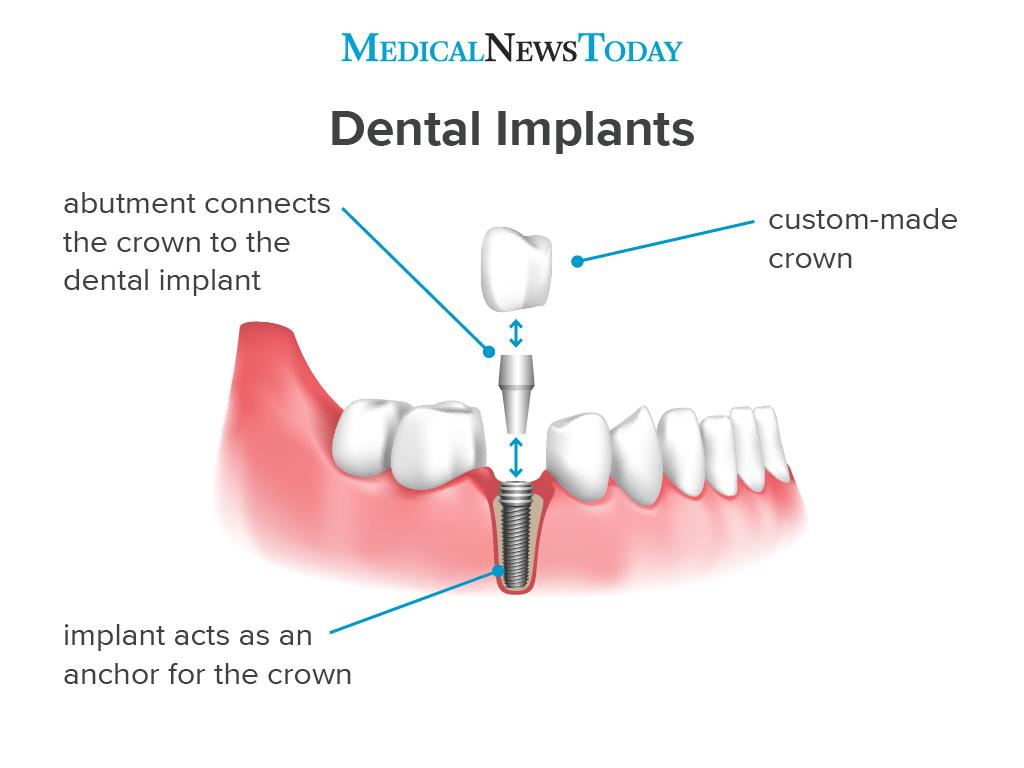Some Of Dental Implants
Some Of Dental Implants
Blog Article
Dental Implants Fundamentals Explained
Table of ContentsLittle Known Facts About Dental Implants.What Does Dental Implants Do?The Single Strategy To Use For Dental Implants8 Easy Facts About Dental Implants Explained
are medical devices surgically dental implanted into the jaw to bring back a person's capability to eat or their look. They offer assistance for synthetic (fake) teeth, such as crowns, bridges, or dentures. When a tooth is shed because of injury or condition, an individual can experience issues such as fast bone loss, defective speech, or modifications to eating patterns that lead to discomfort.
Structure of The Oral Implant System selecting oral implants, speak with your oral company concerning the potential benefits and threats, and whether you are a candidate for the procedure. Things to think about: Your general wellness is an important consider figuring out whether you are a great prospect for oral implants, for how long it will require to recover, and how long the implant might remain in place.
Smoking may influence the recovery process and reduce the long-lasting success of the dental implant. The healing procedure for the dental implant body might take a number of months or longer, during which time you typically have a short-lived abutment in place of the tooth. the dental implant procedure: Thoroughly adhere to the oral health directions given to you by your dental provider.
Unknown Facts About Dental Implants
Implant failure can cause the demand for one more surgery to fix or change the dental implant system. Restores the capability to chew Recovers aesthetic look Aids keep the jawbone from diminishing because of bone loss Preserves the wellness of the surrounding bone and gums Helps keep adjacent (nearby) teeth secure Boosts lifestyle Damage to surrounding natural teeth during dental implant positioning Injury to the surrounding tissues during surgery, such as sinus perforation Injury throughout surgical procedure (as an example, crack of bordering jawbone) Poor feature, such as seeming like the teeth do not bite together generally A feeling that the tooth hangs or turning in location arising from a joint screw loosening Implant body failing (looseness of the dental implant body) due to systemic infection, which may be most likely in patients with unrestrained diabetes due to neighborhood infection in bone and periodontals sustaining the implant body because of postponed browse this site recovery, which might be most likely in patients who smoke Problem cleaning up the periodontals around the implant, leading to inadequate oral hygiene Unattended periodontal illness Post-surgical tingling due to nerve impingement or damages Always notify healthcare providers and imaging professionals that you have oral implants before any magnetic vibration imaging (MRI) or x-ray treatments.
FDA is not knowledgeable about any unfavorable occasions reported for MRI or x-ray treatments with dental implants. Dental implants systems are typically made from materials that adhere to international agreement requirements of the International Company for Standardization (ISO) or ASTM International. These standards have details of what makes a risk-free product.
Other materials such as gold alloys, cobalt-based alloys, titanium alloys, or ceramic materials are occasionally utilized. The safety and security accounts of these materials are well-known. Dental implant systems are examined according to worldwide consensus criteria. Biocompatibility screening, to show that bodily call with the device does not cause complications like irritation or allergic response, is component of the analysis that helps ensure the products in the dental implant system are risk-free and do not trigger unfavorable results when implanted in individuals.

6 Easy Facts About Dental Implants Shown
Some individuals are not qualified for oral implant surgical treatment. It is for dental specialists to operate on people with: acute illnessuncontrollable metabolic diseasebone or soft tissue condition or infectionIf these concerns are fixed, a person can have the surgical treatment. Dental Implants. In, oral doctors abstain from operating individuals with: If individuals with any of the above go through oral implant surgical procedure, there is a higher risk of the implant stopping working
Some people have a jawbone abnormality that avoids sufficient bone for a dental implant from establishing. In such instances, a specialist might require to perform a ridge alteration. This includes raising the gum tissue to subject the area of deformed bone. The surgeon will certainly after that make use of a bone or bone replacement to fix and build up the location.
Dental dental implant surgical procedure is an individualized process. Give you time to heal. Affix the post and last crown, bridge or denture.
Next off, your doctor will meticulously put the oral implant into your jaw. Your specialist will certainly rearrange your periodontals and close the incision with stitches (Dental Implants). If your implant is near the front of your mouth, your dental expert will certainly make a short-term tooth for you to wear up until you recover. That method, you will not have a space in your smile while you recover.
The Facts About Dental Implants Uncovered
During the recovery phase, your jawbone must fuse to the oral implant. This procedure can take anywhere from three to 9 months.
When your dental implant heals, your dentist can affix the abutment (little port post) and your final restoration (crown, bridge or denture). This generally takes concerning one hour to complete and may require a 2nd minor surgery. You investigate this site should not really feel any type of discomfort throughout your dental implant procedure due to the fact that your copyright will use drug to numb your periodontals.
Report this page